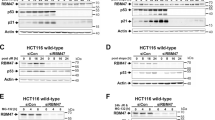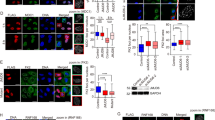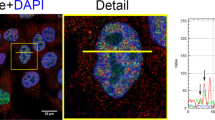Abstract
Ionizing radiation leads to rapid stabilization and activation of the p53 tumor suppressor. Previous reports demonstrate that murine p19ARF cooperates with p53 in the cellular response to gamma irradiation. Here, we show that endogenous ARF sequentially interacts with p53 and MDM2 following irradiation of primary human and mouse embryonic fibroblasts. Shortly after irradiation, p14ARF binds p53 independently of MDM2. As nuclear pools of p53 decline, endogenous p14ARF co-immunoprecipitates with MDM2 and is localized within the nucleolus. Interestingly, p14ARF nucleolar localization during this response is abrogated in cells lacking functional p53. Taken together, our data suggest that human and murine ARF contribute to the mammalian DNA damage response.
This is a preview of subscription content, access via your institution
Access options
Subscribe to this journal
Receive 50 print issues and online access
$259.00 per year
only $5.18 per issue
Buy this article
- Purchase on Springer Link
- Instant access to full article PDF
Prices may be subject to local taxes which are calculated during checkout




Similar content being viewed by others
References
Bates S, Phillips AC, Clark PA, Stott F, Peters G, Ludwig RL and Vousden KH . (1998). Nature, 395, 124–125.
de Stanchina E, McCurrach ME, Zindy F, Shieh SY, Ferbeyre G, Samuelson AV, Prives C, Roussel MF, Sherr CJ and Lowe SW . (1998). Genes Dev., 12, 2434–2442.
Giaccia AJ and Kastan MB . (1998). Genes Dev., 12, 2973–2983.
Groth A, Weber JD, Willumsen BM, Sherr CJ and Roussel MF . (2000). J. Biol. Chem., 275, 27473–27480.
Haupt Y, Maya R, Kazaz A and Oren M . (1997). Nature, 387, 296–299.
Hirao A, Kong YY, Matsuoka S, Wakeham A, Ruland J, Yoshida H, Liu D, Elledge SJ and Mak TW . (2000). Science, 287, 1824–1827.
Honda R and Yasuda H . (1999). EMBO J., 18, 22–27.
Huang LC, Clarkin KC and Wahl GM . (1996). Proc. Natl. Acad. Sci. USA, 93, 4827–4832.
Jones SN, Roe AE, Donehower LA and Bradley A . (1995). Nature, 378, 206–208.
Kamijo T, Bodner S, van de Kamp E, Randle DH and Sherr CJ . (1999a). Cancer Res., 59, 2217–2222.
Kamijo T, van de Kamp E, Chong MJ, Zindy F, Diehl JA, Sherr CJ and McKinnon PJ . (1999b). Cancer Res., 59, 2464–2469.
Kamijo T, Weber JD, Zambetti G, Zindy F, Roussel MF and Sherr CJ . (1998). Proc. Natl. Acad. Sci. USA, 95, 8292–8297.
Kamijo T, Zindy F, Roussel MF, Quelle DE, Downing JR, Ashmun RA, Grosveld G and Sherr CJ . (1997). Cell, 91, 649–659.
Kastan MB, Onyekwere O, Sidransky D, Vogelstein B and Craig RW . (1991). Cancer Res., 51, 6304–6311.
Khan SH, Moritsugu J and Wahl GM . (2000). Proc. Natl. Acad. Sci. USA, 97, 3266–3271.
Khanna KK and Lavin MF . (1993). Oncogene, 8, 3307–3312.
Korgaonkar C, Zhao L, Modestou M and Quelle DE . (2002). Mol. Cell. Biol., 22, 196–206.
Kubbutat MH, Jones SN and Vousden KH . (1997). Nature, 387, 299–303.
Linke SP, Clarkin KC, Di Leonardo A, Tsou A and Wahl GM . (1996). Genes Dev., 10, 934–947.
Llanos S, Clark PA, Rowe J and Peters G . (2001). Nat. Cell Biol., 3, 445–452.
Lohrum MA, Ashcroft M, Kubbutat MH and Vousden KH . (2000a). Curr. Biol., 10, 539–542.
Lohrum MA, Ashcroft M, Kubbutat MH and Vousden KH . (2000b). Nat. Cell Biol., 2, 179–181.
Lyakhovich A and Shekhar MPV . (2003). Mol. Cell. Biol., 23, 2463–2475.
Midgley CA, Desterro JM, Saville MK, Howard S, Sparks A, Hay RT and Lane DP . (2000). Oncogene, 19, 2312–2323.
Momand J, Zambetti GP, Olson DC, George D and Levine AJ . (1992). Cell, 69, 1237–1245.
Montes de Oca Luna R, Wagner DS and Lozano G . (1995). Nature, 378, 203–206.
Palmero I, Pantoja C and Serrano M . (1998). Nature, 395, 125–126.
Pomerantz J, Schreiber-Agus N, Liegeois NJ, Silverman A, Alland L, Chin L, Potes J, Chen K, Orlow I, Lee HW, Cordon-Cardo C and DePinho RA . (1998). Cell, 92, 713–723.
Rubbi CP and Milner J . (2000). Oncogene, 19, 85–96.
Smogorzewska A and De Lange T . (2002). EMBO J., 21, 4338–4348.
Stott FJ, Bates S, James MC, McConnell BB, Starborg M, Brookes S, Palmero I, Ryan K, Hara E, Vousden KH and Peters G . (1998). EMBO J., 17, 5001–5014.
Thut CJ, Goodrich JA and Tjian R . (1997). Genes Dev., 11, 1974–1986.
Wang YA, Elson A and Leder P . (1997). Proc. Natl. Acad. Sci. USA, 94, 14590–14595.
Weber JD, Kuo ML, Bothner B, DiGiammarino EL, Kriwacki RW, Roussel MF and Sherr CJ . (2000). Mol. Cell. Biol., 20, 2517–2528.
Weber JD, Taylor LJ, Roussel MF, Sherr CJ and Bar-Sagi D . (1999). Nat. Cell Biol., 1, 20–26.
Wu X, Bayle JH, Olson D and Levine AJ . (1993). Genes Dev., 7, 1126–1132.
Xu Y and Baltimore D . (1996). Genes Dev., 10, 2401–2410.
Xu Y, Yang EM, Brugarolas J, Jacks T and Baltimore D . (1998). Mol. Cell. Biol., 18, 4385–4390.
Zhang Y and Xiong Y . (1999). Mol. Cell, 3, 579–591.
Zhang Y, Xiong Y and Yarbrough WG . (1998). Cell, 92, 725–734.
Zindy F, Eischen CM, Randle DH, Kamijo T, Cleveland JL, Sherr CJ and Roussel MF . (1998). Genes Dev., 12, 2424–2433.
Acknowledgements
We thank Dr Geoffrey Wahl and Dr Gordon Peters for reagents and helpful discussion. We are grateful to Dr Karen Vousden for providing HDM2 expression vectors, Dr Jamil Momand for the 2A10 reagent, Dr Pui Chan for anti-B23 antibodies and Dr Gigi Lozano for providing p53−/−mdm2−/− MEFs. We also thank Drs Emma Lees and Bruno Amati for critical review of this manuscript. DNAX Research Incorporated is a subsidiary of Schering Plough Corporation.
Author information
Authors and Affiliations
Corresponding author
Rights and permissions
About this article
Cite this article
Khan, S., Guevara, C., Fujii, G. et al. p14ARF is a component of the p53 response following ionizing irradiation of normal human fibroblasts. Oncogene 23, 6040–6046 (2004). https://doi.org/10.1038/sj.onc.1207824
Received:
Revised:
Accepted:
Published:
Issue Date:
DOI: https://doi.org/10.1038/sj.onc.1207824
Keywords
This article is cited by
-
Epigenetics in radiation-induced fibrosis
Oncogene (2015)
-
Cellular senescence: a hitchhiker’s guide
Human Cell (2015)
-
Twilight effects of low doses of ionizing radiation on cellular systems: a bird’s eye view on current concepts and research
Medical Oncology (2010)
-
ARF stimulates XPC to trigger nucleotide excision repair by regulating the repressor complex of E2F4
EMBO reports (2009)
-
Explaining oscillations and variability in the p53-Mdm2 system
BMC Systems Biology (2008)



